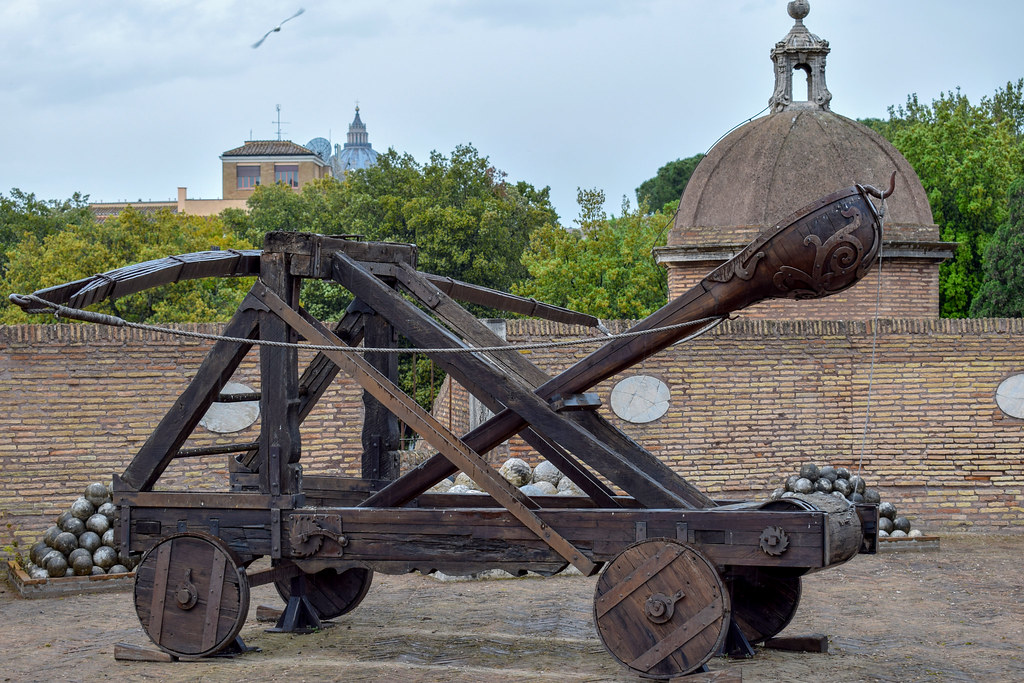

#When was the catapult invented windows
At the same time, Greek fortifications began to feature high towers with shuttered windows in the top, which could have been used to house anti-personnel arrow shooters, as in Aigosthena. Arrow firing machines in action are reported from Philip II's siege of Perinth (Thrace) in 340 BC.

inscription from the island of Ceos in the Cyclades catapult shooting competitions for the young”. Many Greek children were instructed in catapult usage, as evidenced by “a 3rd Century B.C. As the use of catapults became more commonplace, so did the training required to operate them. Another Athenian inventory from 330-329 BC includes catapult bolts with heads and flights. This move to torsion springs was likely spurred by the engineers of Philip II of Macedonia. The later entry is particularly noteworthy as it constitutes the first clear evidence for the switch to torsion catapults which are more powerful than the flexible crossbows and came to dominate Greek and Roman artillery design thereafter. An extant inscription from the Athenian arsenal, dated between 338 and 326 BC, lists a number of stored catapults with shooting bolts of varying size and springs of sinews. įrom the mid-4th century BC onwards, evidence of the Greek use of arrow-shooting machines becomes more dense and varied: Arrow firing machines ( katapaltai) are briefly mentioned by Aeneas Tacticus in his treatise on siegecraft written around 350 BC. This kind of innovation is indicative of the increasing rate at which geometry and physics were being assimilated into military enterprises. The central principle to this theory was that “all parts of a catapult, including the weight or length of the projectile, were proportional to the size of the torsion springs”.

Philo of Byzantium provides probably the most detailed account on the establishment of a theory of belopoietics (“belos” = projectile “poietike” = (art) of making) circa 200 BC. The bows of these machines already featured a winched pull back system and could apparently throw two missiles at once. He probably designed his bow-machines on the occasion of the sieges of Cumae and Milet between 421 BC and 401 BC. Zopyrus has been plausibly equated with a Pythagorean of that name who seems to have flourished in the late 5th century BC. 2nd century BC), whose reliability has been positively reevaluated by recent scholarship, described two advanced forms of the gastraphetes, which he credits to Zopyros, an engineer from southern Italy.

A detailed description of the gastraphetes, or the “belly-bow”, along with a watercolor drawing, is found in Heron's technical treatise Belopoeica. 1st century AD), who referred to the now lost works of the 3rd-century BC engineer Ctesibius, this weapon was inspired by an earlier foot-held crossbow, called the gastraphetes, which could store more energy than the Greek bows. The introduction of crossbows however, can be dated further back: According to the inventor Hero of Alexandria (fl. Diodorus is assumed to have drawn his description from the highly rated history of Philistus, a contemporary of the events then. The weapon was soon after employed against Motya (397 BC), a key Carthaginian stronghold in Sicily. 1st century BC), described the invention of a mechanical arrow-firing catapult ( katapeltikon) by a Greek task force in 399 BC. Primitive catapults were essentially “the product of relatively straightforward attempts to increase the range and penetrating power of missiles by strengthening the bow which propelled them”. Roman 'catapult-nest' in the Trajan's Dacian WarsĬatapult and the crossbow in Greece are closely intertwined. Ancient mechanical artillery: Catapults (standing), the chain drive of Polybolos (bottom center), Gastraphetes (on wall)


 0 kommentar(er)
0 kommentar(er)
